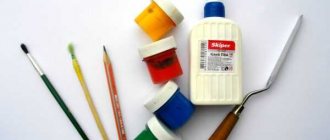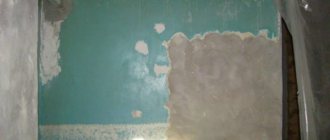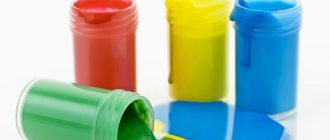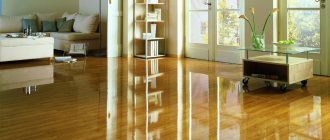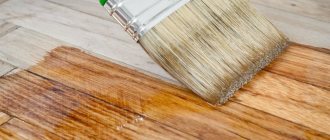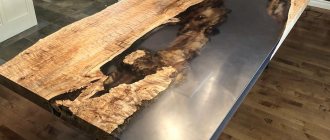Varnish products are widely used in repair, construction and decorative work. The varnish film protects the paint layer from moisture and aggressive factors. Novice painters do not know whether acrylic paint needs to be varnished, so the features and properties of this material should be considered in more detail.
Applying varnish helps protect the surface from fading and moisture.
Why do you need to varnish surfaces?
Applying varnish to a surface painted with acrylic paint may be advisable if it is wooden and susceptible to moisture. For example, a wooden table outdoors or any other wooden product intended for a room with high humidity (ground floor, basement, bathroom).
Moreover, wood is deformed under the influence of the environment. It may be susceptible to attack by pests.
And in order to avoid unpleasant surprises, it makes sense to protect wooden surfaces and products with additional protection.
How to apply yacht varnish
The operation of the varnish provides a set of rules, which guarantees safety and efficiency.
- Carefully clean the surface of the product, eliminating any unevenness and unnecessary elements.
- Temperature requirements are from +150 to +35 degrees C. The required air humidity is 80%. Use a roller, brush or spray.
- Be sure to dry the wood so that moisture levels do not exceed 20%.
- The surface needs a primer before applying varnish.
- The substance is applied in two or three layers.
- Minimum four hours for the varnish to dry. If the substance is not dry, it will be sticky when touched. In this case, the next layer cannot be applied until the previous one has dried.
While working, use construction gloves and a respirator. Finally, be sure to ventilate the room.
Varnish is flammable! You shouldn't throw it down the drain.
Classification by type of varnish
- Varnish for application on acrylic paint. This type of varnish is non-toxic and therefore safe. Suitable for indoor use. Colorless and quick-drying material.
- Varnish based on cellulose nitrates. Nitrolac. Due to its toxicity, the varnish is hazardous to health. When working with it, especially indoors, you should wear a protective mask. Dries quickly.
- Varnish based on alkyd resins, fatty acids and vegetable oils. Alkyd varnish. It takes a long time to dry. Repels moisture.
- Polyurethane varnish. Well protects wood from mechanical stress.
- Epoxy varnish. The material is moisture resistant. Protects against mechanical influences. Dries in 12 hours.
Classification by method of application
- Furniture varnish. It is used in the furniture industry for restoration work. Also applicable in construction.
- Varnish for parquet. Used for parquet floors, varnishing furniture and doors.
- Varnish for decoration. The protective functions of this type of varnish fade into the background; the appearance of the product is important for it.
- Varnish for treating wooden surfaces on boats. Yacht varnish. The peculiarity of this varnish is to protect surfaces and products from aggressive environmental influences, both in fresh and salt water, and on land.
Compatibility of the protective layer with CM
Varnishing gives the painted base a pleasant color. But the varnish and dye must be compatible according to their characteristics. Since water-based CM comes in different types, the varnish is selected for each:
- Water-based acrylic CM is protected with acrylic-based dye varnish. Before painting, the base is treated with a primer with a similar base. Refers to materials that are harmless to health. Universal water-based acrylic varnish Tex “Profi”, capacity 2 l – 696 rubles. It does not change the shade of the colored surface coating unless pigment is added to the base mass.
- Silicone-based water-based CM is not treated with a protective finishing material due to its ability to penetrate deeply into the structure of the base.
- The acrylic water-based composition is protected by a polyurethane varnish composition of medium consistency. A protective layer is formed that lends itself to frequent wet cleaning. Varnish TZ 29xx – polyurethane, transparent, 1 liter – 345 rubles. The protective layer lasts for more than one year.
- Use nitro varnishes carefully on water-based paint. They can cause local damage to the painted surface. They are applied to surfaces outdoors due to the release of a toxic odor. NTs-218 “Krafor” (1.7 kg) for 414 rubles.
When asked whether acrylic paint can be coated with varnish, for example, alkyd, the answer is “no.” The base, decorated with water-based acrylic CM, is treated with a protective layer - acrylic varnish (VGT / VGT acrylic varnish for external and internal work, glossy, 1 kg for 287 rubles). In other words, materials from the same group of paints and varnishes are selected. They must have the same characteristics of substances at the molecular level, then adhesion to the surface will be at a high level. A protective decorative coating is formed that is resistant to ultraviolet rays of the sun, resisting humidity and temperature fluctuations.
Choosing a varnish for acrylic paint
Modern trade can offer its customers a huge selection of paint and varnish products. For every taste and budget, in any volume and any composition. From any manufacturers.
This article offers acrylic paint varnish for consideration. Why it is needed and where it is used was described above. Now let's look at how to choose such a varnish, what parameters you should pay attention to.
Main parameters for selection:
- The varnish must contain acrylic.
- The varnish must be fresh. No more than three months should pass from the moment of its manufacture.
- It is better to choose a matte varnish, since acrylic paint itself has glossy properties.
Applying varnish to other surfaces
Varnishing, as a process of creating a protective layer, is also used on other surfaces. It can be metal, plywood, paper, self-adhesive film. Is it possible to coat the film with varnish?
It is possible if there is a need for it. The main thing is not to make a mistake with the varnish, so as not to damage the top decorative layer of the film and prevent the surface from cracking after drying. For example, nitro varnish, for all its advantages, has significant limitations on its use, but acrylic varnish is a more universal product.
Advantages of acrylic paint varnish
Acrylic varnish is the best coating for acrylic paint, and the ideal composition of such varnish can be called polyurethane.
Advantages of acrylic varnish:
- No smell.
- Non-toxic.
- Dries quickly.
- Instant.
- Viscous.
- Excellent adhesion to acrylic and water-based paints.
- Fits perfectly on any surface.
- Remarkably protects against environmental influences.
- The varnish is absolutely transparent and thanks to this it retains all the color saturation of the paint even when exposed to sunlight.
Can laminate flooring be varnished?
Laminate is a modern laminated floor covering, which today is in great demand, fashionable, widely available and used everywhere. It is made of several layers, the last top special layer protects the material from mechanical damage and provides the surface with an aesthetically smooth appearance.
However, any flooring, including laminate, gradually wears out and loses its former attractiveness. This does not mean that the laminate needs to be replaced with a new one. Many people are convinced that laminated boards can be coated with a layer of this emulsion, and then the flooring can last for a long time. However, experts do not recommend doing this, although this opinion is controversial.
Here are the arguments they give:
- Argument one. The upper part of the laminate board is covered in the form of a protective film. It is this that makes the surface perfectly flat and smooth. This film has no pores, so it will not be able to absorb liquid compounds. In addition, the paint base will not be able to adhere well to the plates, since their adhesion (the ability of different materials to adhere to each other) is weak. Over time, the product will begin to crack and peel off.
- The next factor in the short service life of re-application on laminate is the installation technology. With the floating method of laying laminate panels, in response to the environment (air temperature and humidity), play will occur over time at the joints. This means that the already dried solution will begin to crack and peel.
Preparatory work
In order for the final work to be pleasing to the eye, before applying varnish it is necessary to carry out a number of actions related to preparing the surface for varnishing.
- Cleaning. Clean the surface from dirt and dust.
- Checking the surface for defects. If they are detected, the surface should be sanded and degreased.
- Varnish preparation. Before applying the varnish, it should be heated in a water bath for 5 minutes to a temperature of 50°C. When heating, the mixture must be constantly stirred.
Varnish application process
- If the product is not freshly painted, the paint has faded, then the surface should be painted again.
- Carry out all the preparatory work indicated above.
- Apply varnish only after the paint has completely dried and in good lighting.
- Varnishing should be done with a flute brush with a width of 50 to 150 mm.
- Polish with a dry brush. In a vertical position, apply with a dry brush until it sticks.
- Apply one layer, if necessary two layers of varnish.
It is important that no dust gets on the surface when varnishing. Heavy objects can only be placed after the varnish has completely dried.
After the primer has completely dried, paint the surface.
- First, prepare the coloring agent and mix it well. If necessary, pigment is added to create the desired color. To thoroughly mix the pigment and paint, use a construction-type mixer.
- Then they begin to paint the surface. Apply a thin layer of paint with a brush; no streaks should form on the surface. Instead of a brush, you can use a roller.
- When the first application dries, proceed to the second coating.
After this, the surface is considered prepared for varnishing.
Tips from a pro
If you don’t have confidence in your abilities and are afraid of ruining everything, then of course it’s better to trust a professional master. A person who knows everything about the properties of paints and varnishes and knows how to use them correctly.
If you have confidence, but little experience, let us allow ourselves some advice:
- If the surface is not painted, it should be primed before varnishing.
- Lightly sand the layers of varnish, except the last one, with fine-fiber sandpaper. This will give the surface additional shine and a mirror effect.
- You should choose a matte varnish. Firstly, acrylic paints have their own gloss. Secondly, the matte composition will be able to mask defects and errors, if any.
- You cannot dilute acrylic varnish with drying oil or solvent; if there is such a need, it is better to use clean water for this.
- Apply varnish only when the air humidity is at least 50%. If there is less humidity, the varnish will dry too quickly and crack.
- The surface to be varnished must always be degreased, for example with soapy water.
- To ensure uniform coverage, the varnish should be applied in several thin layers, if there are several of them.
Advantages of varnish coating
The varnish goes very well with the wood. Wooden varnished parquet flooring is deservedly popular among homeowners. What are the advantages of such coverage?
The advantages that varnish provides when treating a wooden floor are obvious:
- increases service life,
- provides protection against damage,
- preserves the original color of the wood,
- guarantees environmental friendliness during operation.
In addition, the varnish coating looks very beautiful and emphasizes the status of the owner of the house.
Photo of the best varnish for acrylic paint
Application technology
Despite the stated high characteristics of deck varnishes, in order to obtain the proper quality of the decorative layer, it is necessary to strictly follow the application recommendations.
If there is a layer of old varnish on the base intended for finishing, you must get rid of it. Otherwise, the new layer will begin to swell and crack.
High-quality varnishing is only possible on a well-dried wooden surface. The permissible level of wood moisture is up to 20%. After drying the base, it should be primed with a liquid containing special antiseptic additives.
Note! In order for the surface to acquire a certain shade, the varnish must be diluted with a suitable dye.
For priming purposes, yacht varnishes are sometimes diluted. The composition containing alkyd resins can be diluted with white spirit or a special thinner recommended by the manufacturer. No thinning is required for basic finishing.
The durability of the finish is ensured by applying 2-3 layers of varnish. The tools usually used are a brush or roller. The product from cans is applied by aerosol.
When applying the first layer, you need to move parallel to the wood fibers. Each subsequent application is carried out in a transverse direction to the previous one. Pauses should be taken between layers to allow them to dry.
Usually after the first application they take a break for 5-6 hours, and after the second - for a day. If work is carried out indoors, use it only after 48 hours.



